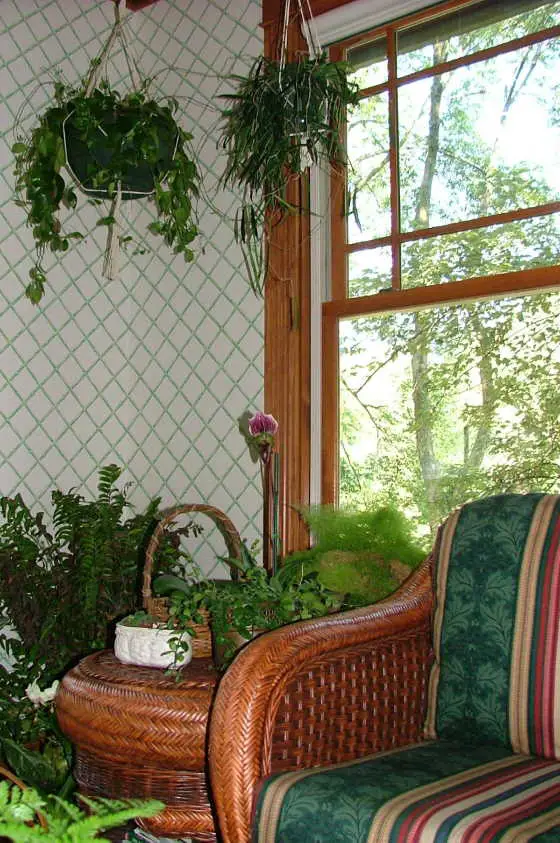Wood Windows

This wood window in my, well actually Kathy's, sunroom is certified. It was made by one of the top window manufacturers in the world. Photo by: Tim Carter
DEAR TIM: My husband and I are getting ready to select wood windows for our new house. We have visited 5 showrooms and are more confused than ever. How do you really determine who makes the best window? What should we be looking for? The salespeople are very polished and make it sound like their product is superior to all others. If I look at another brochure I think I am going to scream. Help! Kelly D., Bismark, ND
DEAR KELLY: I completely understand your frustration and bewilderment. I used to experience the same sensory overload syndrome when the window salespeople would visit my job sites. Trips to the spectacular showrooms just made things worse. Each window looked fabulous and the illustrated, high quality sales literature was intoxicating. Fortunately, you have come to the marketplace at the right time. There are new industry standards and certification programs that allow you to quickly judge the quality of wood and other window products.
Wood windows have come a long way in the last 25 years. The energy crisis of the 1970's created a movement within the window industry to vastly improve the overall performance of windows. The net result was better weatherstripping that minimizes air and water infiltration, high performance insulated Low E glass, and improved designs that help make windows more energy efficient. As each company introduced a "new and improved" window, the decision process for you, I, and countless other consumers became much more difficult. We had no way of easily measuring how one widow really matched up against another. Thankfully, those days are gone forever.
The American Architectural Manufacturers Association (AAMA) in conjunction with the National Wood Window and Door Association (NWWDA) has just produced a new window manufacturing standard - AAMA/NWWDA 101/I.S.2-97. This is a set of voluntary specifications that wood and other window manufacturers can choose to adopt in the manufacturing process. The specifications create minimum performance standards for factory fabricated windows in the following areas: structural adequacy to withstand wind loads, resistance to water leakage, resistance to air infiltration, and forced entry resistance.
Manufacturers who choose to make wood window products that pass all of these standards and agree to independent inspections are issued a certification letter. They are also permitted to apply a special label to each window. The AAMA or NWWDA inspectors can make surprise visits at any time to remove windows from the factory assembly line. If a window doesn't pass, the manufacturer can lose their certification status.
AAMA and NWWDA also have developed independent certification programs for their members. NWWDA's program is called the Hallmark Certification Program. Windows are tested by an independent third party lab. The weatherstripping is tested at a sustained wind velocity of 25 mph. If more than .3 cubic feet of air per minute per square foot of glass surface area passes through the window, it fails the test. Driving rainstorms are simulated. Windows must remain leak-free during a 15 minute test. The test chamber creates a wind driven rainstorm that produces the equivalent of 8 inches of rain per hour whipped by 34 mph winds. If the windows pass additional load tests the manufacturer is permitted to apply a special NWWDA "Hallmark" or an AAMA gold label directly to the window frame.
A third organization, the National Fenestration Rating Council (NFRC), has developed uniform standards to test the thermal performance of windows. A sticker applied to the glass tells you how well the window performs in cold and warm weather. Currently the stickers show a U - factor. This number is directly related to the R- factor number used by the insulation industry. However, it works in reverse. Small U - factor numbers equal BIG energy savings for you. The NFRC rating program is currently working on a more "user-friendly" label that will display two numbers - one for heating and one for cooling. Look for these new labels later this year.
Be sure that the windows you decide to purchase are certified and have the labels to prove it. Verbal promises from salespeople are not sufficient. Each manufacturer or window distributor can easily provide you with a copy of the certification letter or written documentation from one or more of the organizations that their products are certified. If they can't, I suggest that you get back in your car and find a wood window salesperson that will gladly produce this documentation.
If you are looking for a book with invaluable information on tools and materials, detailed instructions for disassembling and repairing all sorts of wood windows then you need a copy of Working Windows. This 125 page book tells you everything you could ever imagine about repair and restoration of wood windows. It lists all of the types, safe and efficient methods of stripping, refinishing and painting, and some neat troubleshooting guides. This book will really help you. To learn even more about windows, be sure to click the Builder Bulletin link just below!
Author's Notes
The National Wood Window and Door Association (NWWDA) has officially changed their name. They are now known as the Window and Door Manufacturers Association (WDMA).
Related Articles: NWWDA Certified Windows, Certified NWWDA Manufacturers, Buy Certified Wood Windows, Storing & Installing Wood Windows